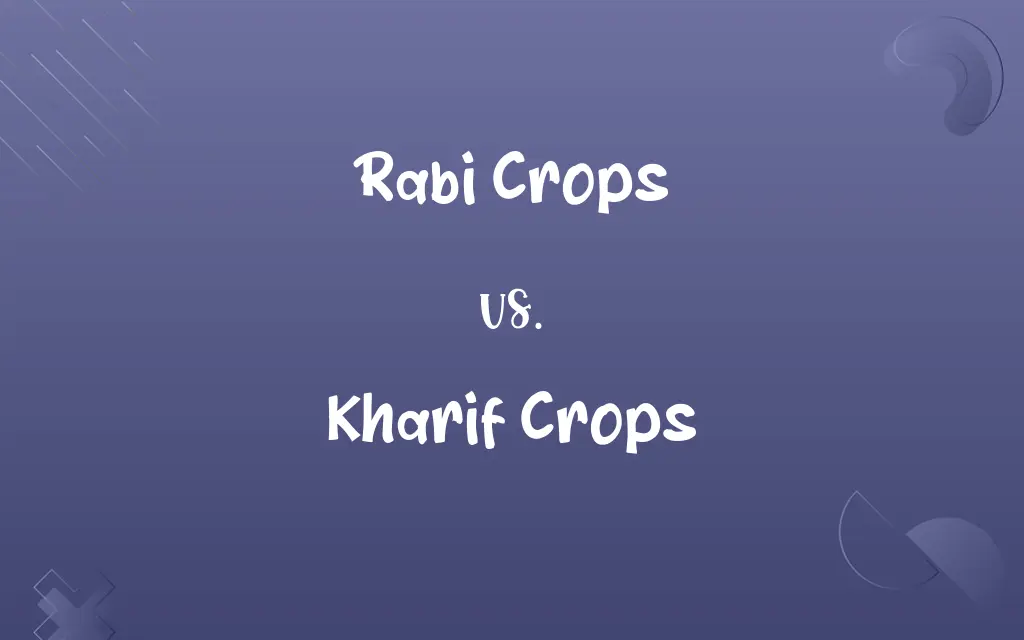Rabi Crops vs. Kharif Crops: Know the Difference

By Shumaila Saeed || Published on December 30, 2023
Rabi crops are grown in winter and harvested in spring, while Kharif crops are grown in the rainy season and harvested in autumn.

Key Differences
Rabi crops are sown in winter, from October to December, and harvested in spring, from April to June. They require a cool growing period and warm harvest period. Examples include wheat and barley. Kharif crops are planted with the onset of the monsoon, around June, and harvested in autumn, around September or October. They thrive in warm wet weather and include crops like rice and maize.
Shumaila Saeed
Dec 30, 2023
Rabi crops generally need less water and rely on the winter rains in addition to irrigation. They are crucial for regions with dry summers. Kharif crops, on the other hand, are heavily dependent on monsoon rains and are predominant in areas with high rainfall.
Shumaila Saeed
Dec 30, 2023
The yield of Rabi crops is often determined by the amount of winter rainfall or availability of irrigation during the growing period. These crops help in crop rotation and soil fertility management. Kharif crops are more prone to weather uncertainties like monsoon delays, which can affect their yield significantly.
Shumaila Saeed
Dec 30, 2023
Rabi crops include wheat, barley, peas, mustard, and lentils, which are essential for food security in many regions. These crops often require proper crop management practices due to the cooler weather conditions. Kharif crops include rice, maize, sorghum, and groundnut, which are staple foods in many parts of the world, especially in Asia and Africa.
Shumaila Saeed
Dec 30, 2023
The market dynamics for Rabi crops often revolve around the spring harvest period and the requirement for storage and distribution before the next winter. Kharif crops typically flood the market immediately after the harvest in autumn and are crucial for sustaining food supplies until the Rabi harvest.
Shumaila Saeed
Dec 30, 2023
ADVERTISEMENT
Comparison Chart
ADVERTISEMENT
Rabi Crops and Kharif Crops Definitions
Rabi Crops
Rabi crops require a warm harvest period.
Mustard, a Rabi crop, is harvested in the warm spring months.
Shumaila Saeed
Dec 13, 2023
Kharif Crops
Kharif crops require warm and wet conditions.
Maize, grown as a Kharif crop, thrives in the monsoon climate.
Shumaila Saeed
Dec 13, 2023
Rabi Crops
Rabi crops are cultivated in cool, dry seasons.
Wheat, a Rabi crop, is sown in winter and harvested in spring.
Shumaila Saeed
Dec 13, 2023
Kharif Crops
Kharif crops are sown with the onset of monsoons.
Rice, a Kharif crop, is planted during the rainy season.
Shumaila Saeed
Dec 13, 2023
Rabi Crops
Rabi crops are sown post-monsoon.
Barley, a typical Rabi crop, is planted after the rains subside.
Shumaila Saeed
Dec 13, 2023
ADVERTISEMENT
Kharif Crops
Kharif crops are dependent on monsoon rains.
Sorghum, a Kharif crop, relies heavily on timely monsoon rains.
Shumaila Saeed
Dec 13, 2023
Rabi Crops
Rabi crops often need irrigation.
Peas, grown as a Rabi crop, require controlled irrigation in winter.
Shumaila Saeed
Dec 13, 2023
Kharif Crops
Kharif crops are harvested in autumn.
Groundnut, harvested in autumn, is a key Kharif crop.
Shumaila Saeed
Dec 13, 2023
Rabi Crops
Rabi crops are harvested before the onset of the summer heat.
Lentils, a Rabi crop, are harvested in spring before temperatures rise.
Shumaila Saeed
Dec 13, 2023
Kharif Crops
Kharif crops are predominant in high rainfall areas.
Jowar, a typical Kharif crop, is common in regions with heavy rains.
Shumaila Saeed
Dec 13, 2023
Repeatedly Asked Queries
Are Rabi crops affected by summer weather?
Rabi crops are harvested before the summer heat, so they are less affected.
Shumaila Saeed
Dec 30, 2023
What climatic conditions favor Rabi crops?
Cool growing and warm harvesting conditions are ideal for Rabi crops.
Shumaila Saeed
Dec 30, 2023
How do Rabi crops manage water requirements?
Rabi crops require less water and often rely on winter rains and irrigation.
Shumaila Saeed
Dec 30, 2023
When are Kharif crops sown and harvested?
Kharif crops are sown with the onset of monsoons (Jun-Jul) and harvested in autumn (Sep-Oct).
Shumaila Saeed
Dec 30, 2023
Can Kharif crops survive in dry conditions?
Kharif crops generally require ample water and struggle in dry conditions.
Shumaila Saeed
Dec 30, 2023
What conditions are essential for Kharif crops?
Warm and wet conditions, typically during the monsoon, are essential.
Shumaila Saeed
Dec 30, 2023
When are Rabi crops usually sown and harvested?
Rabi crops are sown in winter (Oct-Dec) and harvested in spring (Apr-Jun).
Shumaila Saeed
Dec 30, 2023
What are some common Rabi crops?
Wheat, barley, peas, and mustard are common Rabi crops.
Shumaila Saeed
Dec 30, 2023
How does the monsoon affect Kharif crops?
A good monsoon season leads to a bountiful harvest of Kharif crops.
Shumaila Saeed
Dec 30, 2023
Do Kharif crops have a shorter market cycle?
Kharif crops often have a shorter market cycle due to immediate post-harvest selling.
Shumaila Saeed
Dec 30, 2023
How do irrigation practices differ between the two crop types?
Rabi crops often need supplementary irrigation, while Kharif crops rely more on natural rainfall.
Shumaila Saeed
Dec 30, 2023
What happens to Kharif crops during a delayed monsoon?
Delayed monsoons can adversely affect the yield of Kharif crops.
Shumaila Saeed
Dec 30, 2023
Are Rabi crops stored for longer periods?
Rabi crops, like wheat, are often stored longer due to their post-harvest period.
Shumaila Saeed
Dec 30, 2023
Are fertilizers used differently in Rabi and Kharif crops?
Yes, the type and amount of fertilizer can vary based on the crop and its seasonal requirements.
Shumaila Saeed
Dec 30, 2023
Do Rabi crops need specific soil types?
Rabi crops can grow in various soil types but often prefer well-drained soils.
Shumaila Saeed
Dec 30, 2023
Can the same land be used for both Rabi and Kharif crops?
Yes, many farmers practice crop rotation, using the same land for different crops in different seasons.
Shumaila Saeed
Dec 30, 2023
What impact do Rabi and Kharif crops have on food security?
Together, Rabi and Kharif crops ensure a year-round supply of various food grains, contributing significantly to food security.
Shumaila Saeed
Dec 30, 2023
Are Kharif crops more prone to weather uncertainties?
Yes, Kharif crops are more vulnerable to weather changes, especially monsoon variability.
Shumaila Saeed
Dec 30, 2023
What are some examples of Kharif crops?
Rice, maize, sorghum, and groundnut are typical Kharif crops.
Shumaila Saeed
Dec 30, 2023
What is the significance of Rabi crops in agriculture?
Rabi crops are crucial for crop rotation and maintaining soil fertility.
Shumaila Saeed
Dec 30, 2023
Share this page
Link for your blog / website
HTML
Link to share via messenger
About Author
Written by
Shumaila SaeedShumaila Saeed, an expert content creator with 6 years of experience, specializes in distilling complex topics into easily digestible comparisons, shining a light on the nuances that both inform and educate readers with clarity and accuracy.









































































